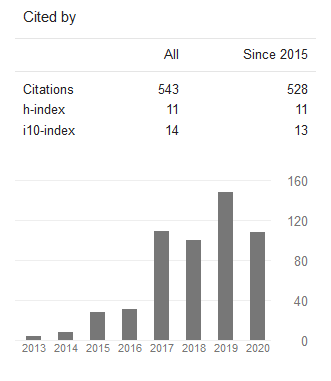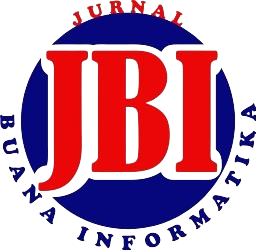Penerapan Metode Fast Independent Component Analysis (FastICA) dalam Memisahkan Vokal dan Instrumen Seni Geguntangan
DOI:
https://doi.org/10.24002/jbi.v13i1.5693Keywords:
Pesantian, Geguntangan, BSS, FastICA, Deflationary BasedAbstract
Abstract. Application of Fast Independent Component Analysis (Fastica) Method in Separating Vocals and Instruments in Geguntangan. Gamelan Geguntangan is often used in religious ceremonies to accompany ceremonies and entertain the public. Along with its development, the Geguntangan gamelan is also used to accompany the Pesantian. Geguntangan recording plays instruments and vocal sounds, most of which have been mixed. The mixed sounds caused the learning process to be less effective for people who will study Pesantian. The students could not focus because of the distracting sound of the instrument. This study aims to separate the sound of instruments and vocals of Geguntangan using deflationary-based FastICA. The non-linear function used is Logcosh. This study also examines the effect of mixing matrix variables and alpha values on non-linear functions on SDR, SIR, and SAR values. The results of the paired t-test carried out by these two values did not have a significant effect on SDR, SIR, and SAR. The difference in the average time of the mixing matrix testing process is 0.09 seconds and 0.42 seconds for testing the alpha value.
Keywords: Pesantian, Geguntangan, BSS, FastICA, Deflationary Based.
Abstrak. Gamelan Geguntangan sering dipakai dalam upacara keagamaan baik untuk mengiringi jalannya upacara dan hiburan masyarakat. Seiring perkembangannya, gamelan Geguntangan juga digunakan untuk mengiringi Pesantian. Pada rekaman Geguntangan terdapat suara instrumen dan vokal yang sebagian besarnya sudah tercampur. Hal ini menyebabkan proses belajar yang kurang efektif bagi orang yang akan belajar Pesantian. Para pemelajar tidak bisa fokus karena adanya suara instrumen yang mengganggu. Penelitian ini bertujuan untuk memisahkan suara instrumen dan vokal seni Geguntangan menggunakan deflationary based FastICA. Fungsi non linear yang digunakan adalah Logcosh. Penelitian ini juga menguji pengaruh variabel matriks pencampuran dan nilai alpha pada fungsi non-linear terhadap nilai SDR, SIR dan SAR. Hasil uji-t berpasangan yang dilakukan kedua nilai ini tidak mempunyai pengaruh yang signifikan terhadap SDR, SIR dan SAR. Selisih rata-rata waktu proses pengujian matriks pencampuran ialah 0.09 detik dan 0.42 detik untuk pengujian nilai alpha.
Kata Kunci: Pesantian, Geguntangan, BSS, FastICA, Deflationary Based.
References
M. A. Firstanto and E. Widjiati, “Kombinasi Metode Independent Component Analysis(ICA) dan Beamforming untuk Pemisahan Sinyal Akustik Bawah Air,” J. Tek. POMITS, vol. 2, no. 2, p. A-300-A-305, 2013.
N. Hassan and D. A. Ramli, “A Comparative study of Blind source separation for Bioacoustics sounds based on FastICA, PCA and NMF,” Procedia Comput. Sci., vol. 126, pp. 363–372, 2018, doi: 10.1016/j.procS.2018.07.270.
S. Nikam and S. Deosarkar, “Fast ICA based technique for non-invasive fetal ECG extraction,” Conf. Adv. Signal Process. CASP 2016, no. 1, pp. 60–65, 2016, doi: 10.1109/CASP.2016.7746138.
W. Indra, P. Sari, I. Wirawan, I. Endang, and W. M. Eng, “PEMISAHAN SINYAL AKUSTIK BAWAH AIR MENGGUNAKAN METODE BLIND SEPARATION of SOURCE ( BSS ),” Undergrad. Thesis Electr. Eng. RSE 620.2 Sar p, 2011, pp. 1–6, 2011.
A. Hyvarinen, J. Karhunen, and E. Oja, Independent Component Analysis. Espoo, Finland: A Wiley-Interscience Publication, 2001.
A. P. Putra, N. W. Wiantari, N. Putu, and M. Novita, “Independent Component Analysis ( ICA ) dan Sparse Component Analysis ( SCA ) dalam Pemisahan Vokal dan Instrumen pada Seni Geguntangan,” J. Elektron. Ilmu Komput. Udayana Vol. 8, No 1. Agustus 2019, vol. 8, no. 1, pp. 105–111, 2019.
K. Liang and J. Ye, “ICA-based image denoising: A comparative analysis of four classical algorithms,” 2017 IEEE 2nd Int. Conf. Big Data Anal. ICBDA 2017, pp. 709–713, 2017, doi: 10.1109/ICBDA.2017.8078728.
J. Miettinen, K. Nordhausen, and S. Taskinen, “FICA: FastICA algorithms and their improved variants,” R J., vol. 10, no. 2, pp. 148–158, 2019, doi: 10.32614/RJ-2018-046.
S. Esmaeiloghli, S. H. Tabatabaei, S. Hosseini, and Y. Deville, “Contribution of deflation-based FastICA to the separation of geochemical signals in the field of mining geochemistry: A case study on the Kuh Panj porphyry system, Kerman, Iran,” 2nd TRIGGER Int. Conf. Trans-disciplinary Res. Iran. Geol. Geodyn. Earthquakes Resour.,
no. November, pp. 12–14, 2018.
P. Xu and Y. Jia, “Blind source separation based on source number estimation and fastica with a novel non-linear function,” Proc. Rom. Acad. Ser. A - Math. Phys. Tech. Sci. Inf. Sci., vol. 21, no. 2, pp. 187–193, 2020.
E. Ollila, “ON THE ROBUSTNESS OF THE DEFLATION-BASED FASTICA ESTIMATOR,” 2009 IEEE/SP 15th Work. Stat. Signal Process., no. 2, pp. 673–676, 2009.
E. Vincent, R. Gribonval, and C. Févotte, “Performance Measurement in Blind Audio Source Separation,” IEEE Trans. Audio. Speech. Lang. Processing, vol. 14, no. 4, pp. 1462–1469, 2006.
Downloads
Published
Issue
Section
License

This work is licensed under a Creative Commons Attribution-ShareAlike 4.0 International License.
Copyright of this journal is assigned to Jurnal Buana Informatika as the journal publisher by the knowledge of author, whilst the moral right of the publication belongs to author. Every printed and electronic publications are open access for educational purposes, research, and library. The editorial board is not responsible for copyright violation to the other than them aims mentioned before. The reproduction of any part of this journal (printed or online) will be allowed only with a written permission from Jurnal Buana Informatika.
This work is licensed under a Creative Commons Attribution-ShareAlike 4.0 International License.










